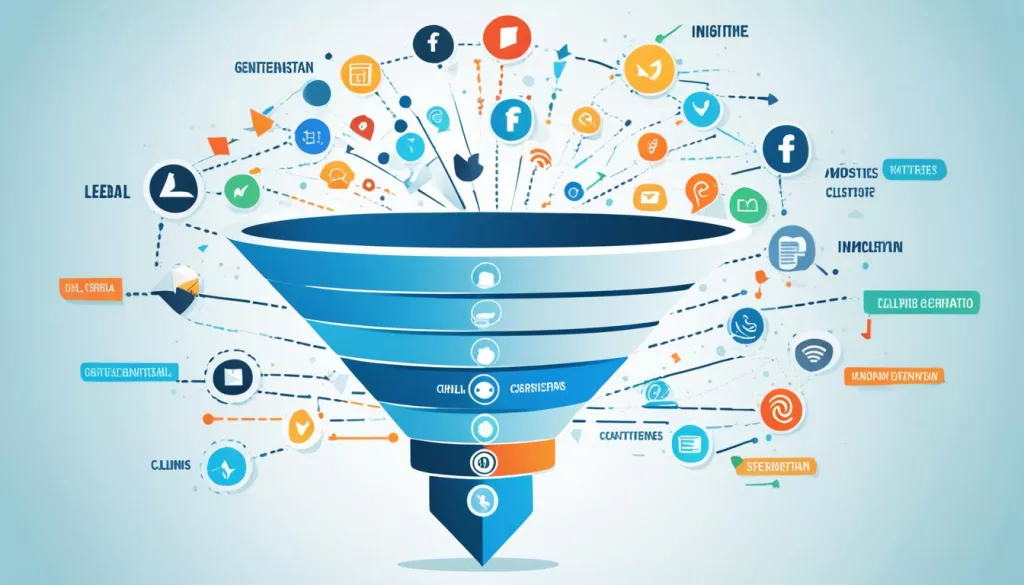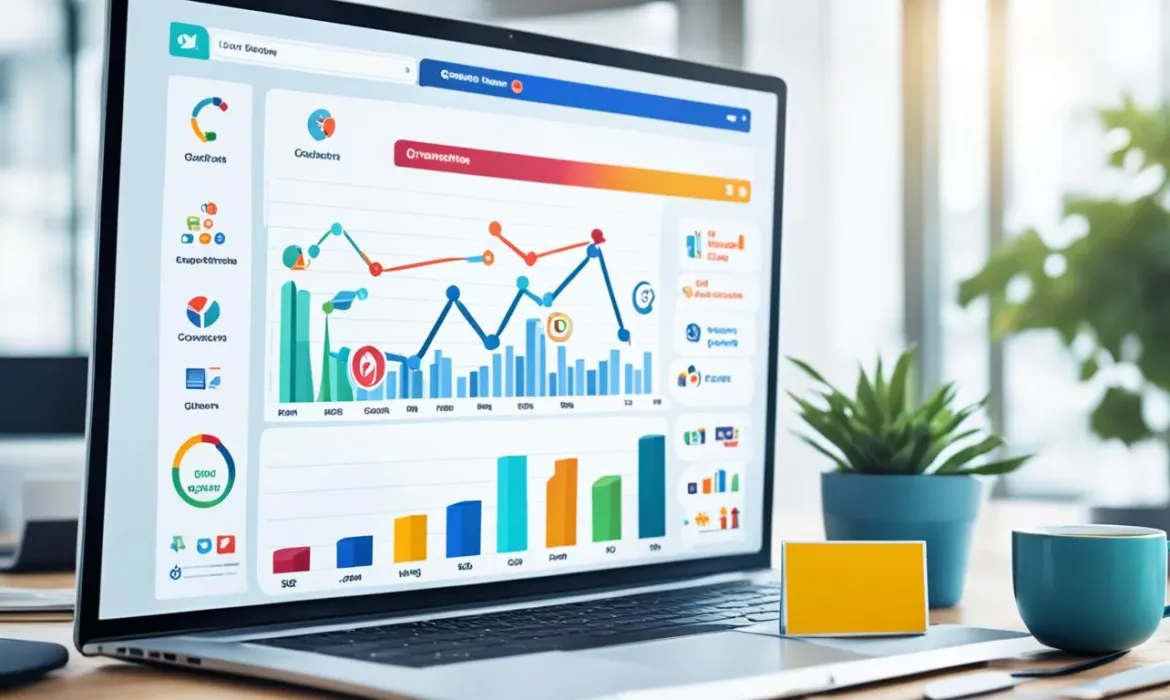Are you looking to fuel your business growth by reaching more potential customers online? One effective way to accomplish this is through lead generation strategies. Online lead generation is the process of capturing consumer interest in your products and services on the internet, ultimately converting them into valuable leads. By implementing digital marketing for lead generation, businesses can attract and engage with their target audience, turning them into potential customers.
Whether you’re a small business owner or a seasoned marketer, understanding the intricacies of online lead generation is crucial for driving success. In this article, we will explore the different aspects of lead generation and provide you with time-tested techniques to generate leads online.
With the ever-increasing importance of digital marketing and the widespread use of the internet, lead generation has become an indispensable part of any business’s marketing strategy. By effectively capturing and nurturing leads, businesses can fuel their growth and achieve their sales objectives.
Key Takeaways:
- Online lead generation is the process of capturing consumer interest in your products and services on the internet.
- It involves attracting leads through inbound and outbound marketing strategies.
- Inbound leads are attracted through marketing efforts, such as content creation and webinars.
- Outbound leads are reached through methods like cold calling and social media advertising.
- Lead generation is essential for the growth and success of businesses in the digital age.
What Is Lead Generation?
Lead generation is the process of proactively attracting potential customers, or leads, with the goal of converting them into paying customers. It can be categorized into two types: inbound lead generation and outbound lead generation.
Inbound lead generation involves attracting leads who show interest in your products or services through various actions, such as filling out inquiry forms or downloading e-books. This strategy focuses on creating valuable content and providing solutions to address the needs and pain points of your target audience. By offering relevant and informative resources, you can attract high-quality leads that are genuinely interested in what your business offers.
Outbound lead generation, on the other hand, involves reaching out to target audiences, whether or not they have expressed interest, through methods like cold calling and mass emailing. This approach allows you to proactively engage with potential customers, even if they haven’t shown specific interest in your offerings. By targeting specific demographics or industries, you can reach a wider audience and generate leads that might not have found your business otherwise.
Both inbound and outbound lead generation strategies have their advantages and limitations. Inbound lead generation tends to be more cost-effective and focuses on attracting leads that are actively searching for solutions. Outbound lead generation, on the other hand, allows you to reach a larger audience and take a more proactive approach in targeting potential customers.
Ultimately, the choice between inbound and outbound lead generation depends on your specific business goals, target audience, and available resources. By understanding the differences between these strategies, you can develop a comprehensive lead generation plan that effectively drives your business growth.

Benefits of Inbound and Outbound Lead Generation
| Inbound Lead Generation | Outbound Lead Generation |
|---|---|
| Targets leads actively searching for solutions | Reaches a wider audience, including those who may not be actively searching |
| Builds trust and credibility through valuable content | Allows for direct communication and personalized outreach |
| Cost-effective in the long run | Can generate immediate results |
| Requires ongoing content creation and optimization | Relies on precise targeting and effective messaging |
Types of Leads
When it comes to lead generation, it’s essential to understand the different types of leads that you may encounter. This knowledge can help you tailor your marketing strategies and effectively nurture potential customers to conversion. Let’s explore four types of leads commonly encountered in lead generation efforts:
1. Marketing Qualified Leads (MQLs)
Marketing qualified leads are individuals who have engaged with your marketing team and have shown interest in your products or services. These leads are typically not ready for direct sales but have the potential to convert into paying customers with proper nurturing. MQLs may have interacted with your website, downloaded gated content like e-books, or subscribed to your newsletter. They have demonstrated a level of engagement that indicates some interest in your offerings.
2. Sales Qualified Leads (SQLs)
Sales qualified leads are contacts who have expressed direct interest in purchasing your product or service. These leads typically meet specific criteria that indicate their readiness for sales engagement, such as requesting a product demo, submitting a price inquiry, or contacting your sales team directly. SQLs are further along in the buyer’s journey and require more personalized attention from your sales team to guide them through the sales process.
3. Product Qualified Leads (PQLs)
Product qualified leads are customers who have already tried your product, usually in its free or trial version, and have shown interest in upgrading to a paid version or purchasing additional features. PQLs have firsthand experience with your product and have reached a level where they see value in your offerings. These leads require targeted marketing and sales efforts to educate them about the benefits of upgrading or expanding their usage of your product.
4. Service Qualified Leads (SQLs)
Service qualified leads are customers who have expressed interest in your product or service and have also shown interest in additional offerings or services. These leads may require upselling or cross-selling to increase their lifetime value. For example, a customer who purchased a software subscription may express interest in training sessions or consulting services related to your product. SQLs offer opportunities to provide added value and deepen the relationship with your customers.
Understanding the different types of leads allows you to tailor your lead generation strategies to effectively nurture leads through the buyer’s journey. By providing relevant and targeted content, personalized communication, and appropriately timed offers, you can guide leads from initial interest to conversion.
How Online Lead Generation Works: 4 Simple Steps
The online lead generation process consists of four simple steps that enable businesses to capture and nurture leads effectively. Understanding this process is crucial for optimizing your lead generation strategies and driving business growth.
Step 1: Prospects Discover Your Business
Prospects become aware of your business through various marketing channels, such as social media platforms and webinars. These channels serve as effective touchpoints to attract potential leads and generate interest in your products or services.
Step 2: Engaging Content Leads to a Landing Page
Once prospects are drawn to your business, they engage with your content, which prompts them to visit a landing page on your website. This content can include blog posts, videos, or other forms of valuable information that align with your target audience’s interests and needs.

Step 3: Capturing Leads through Contact Information
On the landing page, you offer prospects an incentive, such as an e-book or a newsletter subscription, in exchange for their contact information. This valuable resource serves as a lead magnet, enticing prospects to provide their details and establish an initial connection with your business.
Step 4: Effective Lead Nurturing in CRM
After capturing the leads, you store their information in a customer relationship management (CRM) software. This allows you to manage and track their interactions with your business. Through lead nurturing, you can build meaningful relationships with these prospects by continuously communicating with them, providing valuable content, and guiding them through the decision-making process.
| Step | Action |
|---|---|
| Step 1 | Prospects discover your business through marketing channels |
| Step 2 | Engagement with your content leads to a landing page |
| Step 3 | Leads are captured through contact information exchange |
| Step 4 | Leads are stored and nurtured in a CRM for effective communication |
By following these four simple steps, businesses can optimize their online lead generation process, capture valuable leads, nurture them effectively, and ultimately establish strong customer relationships.
5 Ways Lead Generation Helps Small Businesses
Lead generation offers several benefits for small businesses. It is a crucial aspect of a successful marketing strategy that can drive growth and increase revenue. Here are 5 ways lead generation can help small businesses:
1. Build Brand Awareness and Visibility
Lead generation plays a key role in building brand awareness and visibility for your small business. By generating customer interest in your products and services, you can attract potential customers and create brand recognition. When prospects start trusting your brand, they are more likely to share their contact information and eventually make a purchase.
2. Generate Business Opportunities
A strong lead generation strategy can open doors to new business opportunities for small businesses. It can lead to collaborations, partnerships, and strategic alliances that can help expand your customer base and reach new markets. By attracting leads who are genuinely interested in your offerings, lead generation increases the chances of converting them into valuable business relationships.
3. Improve Lead Quality
Lead generation not only helps attract potential customers but also ensures that the leads you generate are of high quality. By implementing targeted lead generation techniques, you can attract leads who are specifically interested in your products or services. This means that you have a higher chance of converting these leads into paying customers, as they are already interested in what you have to offer.
4. Reduce Dependence on Outbound Marketing
Lead generation allows small businesses to rely less on expensive outbound marketing efforts. Instead of reaching out to a wide audience through traditional advertising methods, lead generation allows you to target specific customer segments. By focusing your efforts on attracting leads who are more likely to be interested in your offerings, you can save time and resources while still achieving effective results.
5. Target Online Brand Awareness
In the era of digital marketing, online brand awareness is crucial for small businesses. Lead generation helps create online brand awareness through various channels, such as social media, content marketing, and search engine optimization. By utilizing these channels effectively, you can increase your online presence, reach a wider audience, and establish your brand as a trusted authority in your industry.
In summary, lead generation offers significant benefits for small businesses, including building brand awareness, generating business opportunities, improving lead quality, reducing dependence on outbound marketing, and targeting online brand awareness. By implementing a comprehensive lead generation strategy, small businesses can create a steady stream of qualified leads and achieve long-term success.
How To Generate Leads Online: 8 Time-Tested Techniques
When it comes to generating leads online, there are several tried and tested techniques that can help your business attract and convert potential customers. By implementing these strategies, you can optimize your online presence, create valuable content, and engage with your target audience. Let’s explore eight effective techniques for online lead generation:
1. Search Engine Optimization (SEO)
SEO is a fundamental technique for improving your website’s visibility and attracting organic traffic from search engines. By optimizing your website’s content, structure, and performance, you can increase your chances of ranking higher in search engine results pages and reaching your target audience.
2. Content Marketing
Content marketing plays a crucial role in attracting and engaging leads. By creating high-quality, informative content that addresses your audience’s pain points and offers valuable insights, you can establish your brand as an authority in your industry and build trust with your target audience.
3. Blogging
Regularly publishing blog posts related to your industry, products, or services can help you attract organic traffic and drive leads to your website. By targeting specific keywords and providing valuable information, you can position your brand as a reliable resource and capture the attention of potential customers.
4. Social Media Marketing
Social media marketing allows you to connect with your target audience on platforms they frequent. By sharing engaging content, running targeted ads, and participating in conversations, you can build a community of followers who are interested in your offerings and generate leads through social media channels.
5. Webinars
Hosting webinars is a powerful way to make personal connections with your audience and generate leads. By offering valuable insights, expert advice, and interactive sessions, you can capture the interest of potential customers and nurture them towards making a purchase.
6. Industry Research Reports
Industry research reports help establish your brand’s credibility and provide valuable information to your target audience. By conducting thorough research and sharing your insights through informative reports, you can attract leads who are actively seeking solutions and position your brand as an industry leader.
7. White Papers or E-books
Creating white papers or e-books allows you to offer in-depth information and insights to your audience. By addressing common challenges and providing practical solutions, you can attract leads who are at the consideration stage and position your brand as a trusted source of expertise.
8. Newsletters
Sending regular newsletters to your subscribers keeps your brand top of mind and helps you stay connected with potential customers. By providing valuable content, exclusive offers, and updates, you can keep leads engaged, nurture their interest, and ultimately convert them into paying customers.
By incorporating these proven techniques into your lead generation strategy, you can effectively attract, nurture, and convert potential customers online. Whether through search engine optimization, content marketing, webinars, or industry research reports, each technique offers unique benefits and contributes to the growth of your business.
| Technique | Benefits |
|---|---|
| Search Engine Optimization (SEO) | Increase organic traffic and visibility |
| Content Marketing | Establish authority, build trust, and engage leads |
| Blogging | Target specific keywords and attract organic traffic |
| Social Media Marketing | Build a community, promote offerings, and generate leads |
| Webinars | Make personal connections and nurture leads |
| Industry Research Reports | Establish credibility and provide valuable information |
| White Papers or E-books | Attract leads actively seeking solutions |
| Newsletters | Keep leads engaged and informed |
Conclusion
Effective lead generation is a fundamental aspect of a successful digital marketing strategy. By adopting the right lead generation strategies, businesses can effectively attract and convert potential customers into valuable paying customers. It is crucial to understand the different types of leads, the lead generation process, and the various techniques available for generating online leads. By leveraging the power of inbound and outbound marketing, optimizing your website, and driving qualified traffic, you can generate a steady stream of online leads that contribute to the growth and success of your business.
Lead generation strategies play a vital role in expanding your customer base and increasing your business’s revenue. By utilizing appropriate techniques such as search engine optimization (SEO), content marketing, social media marketing, webinars, industry research reports, white papers, and newsletters, you can effectively attract and engage with your target audience, cultivating strong relationships and guiding them towards making a purchase decision.
Remember, the key to effective lead generation is to consistently deliver valuable and relevant content that resonates with your audience’s needs and interests. By continuously adapting and refining your lead generation strategies based on data and insights, you can optimize your efforts and maximize the return on investment.
In conclusion, generating online leads through strategic lead generation efforts is a powerful way to grow your business and attain long-term success. By implementing the right lead generation strategies, you can boost brand awareness, increase customer engagement, and drive conversions, ultimately driving business growth and achieving your goals.
FAQ
How can I generate online leads for my business?
Generating online leads for your business involves implementing effective lead generation strategies, such as search engine optimization (SEO), content marketing, social media marketing, webinars, industry research reports, white papers, and newsletters.
What is lead generation?
Lead generation is the process of attracting potential customers, or leads, with the goal of converting them into paying customers. It can be categorized into inbound lead generation, which involves attracting leads who have shown interest, and outbound lead generation, which involves reaching out to target audiences.
What are the different types of leads?
There are different types of leads, including marketing qualified leads, sales qualified leads, product qualified leads, and service qualified leads. Each type represents a different stage of the customer journey and requires tailored lead nurturing strategies.
How does online lead generation work?
The online lead generation process generally involves four steps. Prospects discover your business through marketing channels, engage with your content, provide their contact information on a landing page, and are stored in a CRM software for lead nurturing and eventual conversion.
What are the benefits of lead generation for small businesses?
Lead generation helps small businesses build brand awareness, generate business opportunities, improve lead quality, reduce marketing costs, and target specific customer segments, leading to growth and success.
How can I generate leads online?
To generate leads online, you can use techniques such as search engine optimization, content marketing, blogging, social media marketing, webinars, industry research reports, white papers, and newsletters. These strategies help attract and engage potential customers.
Why is lead generation important for digital marketing?
Lead generation is an essential component of a successful digital marketing strategy because it allows businesses to attract and convert potential customers into paying customers. Effective lead generation strategies drive growth and contribute to the success of businesses online.





